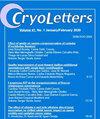念珠百合种质的冷冻保存:冷冻前和冷冻后处理分析。
IF 0.9
4区 生物学
Q3 BIOLOGY
引用次数: 0
摘要
背景念珠百合(Lilium candidum L.)是一种多年生观赏植物,具有多种药用价值,并被用于化妆品行业。该物种正面临着城市化和气候变化的威胁,急需保护。长期储存植物遗传资源最安全有效的技术是低温保存,即在极低的温度下保存遗传物质。 目标 如今,由于自然分布区缩小和/或出于不同目的的破坏,植物生物多样性濒临灭绝。本研究的重点是利用嫩枝尖和胼胝体作为外植体来源,创建低温保存过程,以长期保护念珠菌物种。 材料与方法 自然分布于土耳其三个不同地区(巴利克希尔省的凯普苏特、艾登省巴法湖周围地区和费特希耶-穆格拉)的念珠菌种群在体外生长,以提供芽尖和胼胝体外植体。在采用液滴玻璃化和玻璃化技术进行冷冻之前,嫩枝尖和胼胝体均用 MS 营养培养基处理,该培养基中添加了每升含 7 克琼脂的 0.4 M 蔗糖和植物玻璃化溶液 2(PVS2)。 结果 在 PVS2 处理 90 分钟后,冷冻保存的嫩枝尖显示出最高的再生水平(71.8%),而在 PVS2 暴露 60 分钟后,胼胝体显示出最高的再生水平(63.9%)。 结论 使用本文所述的各种低温保存程序保存芽尖和胼胝体外植体时,可产生高水平的再生。这使得该方法有望长期保存濒危的念珠菌品种。Doi.org/10.54680/fr23510110512.本文章由计算机程序翻译,如有差异,请以英文原文为准。
Cryopreservation of Lilium candidum germplasm: analysis of pre- and post-freeze treatments.
BACKGROUND Lilium candidum L. is a perennial ornamental plant that has various medicinal properties and is used in the cosmetic industry. The species is facing threats from urbanization and climate change and requires urgent protection. The most secure and efficient technology for the long-term storage of plant genetic resources is cryopreservation, which involves preserving genetic material at extremely low temperatures. OBJECTIVE Today, plant biodiversity is endangered because of the narrowing of its natural distribution areas and/or destruction for different purposes. This study concentrated on creating a cryopreservation process using shoot tips and calluses as explant sources for the long-term conservation of L. candidum species. MATERIALS AND METHODS Populations of L. candidum naturally distributed from three different regions of Turkey (Kepsut, Balikesir; the area surrounding Bafa Lake, Aydin; and Fethiye-Mugla) were grown in vitro to supply shoot tip and callus explants. Prior to freezing by droplet-vitrification and vitrification techniques, shoot tips and calluses were treated with MS nutritional medium supplemented with 0.4 M sucrose 7 g per L agar and plant vitrification solution 2 (PVS2). RESULTS Cryopreserved shoot tips showed the highest levels of regeneration (71.8%) after a PVS2 treatment of 90 min, while calluses showed the highest levels of regrowth (63.9%) after a PVS2 exposure of 60 min. CONCLUSION High levels of regrowth are produced when the various cryopreservation procedures described here are used to preserve both shoot tip and callus explants. This potentially makes the method promising for the long-term preservation of endangered L. candidum varieties. Doi.org/10.54680/fr23510110512.
求助全文
通过发布文献求助,成功后即可免费获取论文全文。
去求助
来源期刊

Cryo letters
生物-生理学
CiteScore
1.80
自引率
10.00%
发文量
50
审稿时长
1 months
期刊介绍:
A bimonthly international journal for low temperature sciences, including cryobiology, cryopreservation or vitrification of cells and tissues, chemical and physical aspects of freezing and drying, and studies involving ecology of cold environments, and cold adaptation
The journal publishes original research reports, authoritative reviews, technical developments and commissioned book reviews of studies of the effects produced by low temperatures on a wide variety of scientific and technical processes, or those involving low temperature techniques in the investigation of physical, chemical, biological and ecological problems.
 求助内容:
求助内容: 应助结果提醒方式:
应助结果提醒方式:


